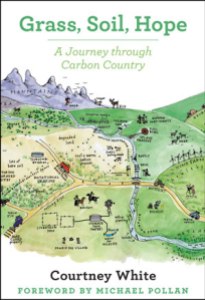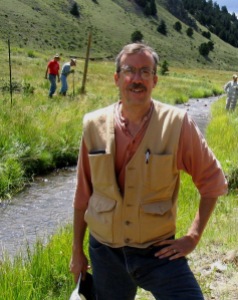
Dirt? What do you mean dirt?
My mind flooded with questions as I delve into Courtney White’s book, Grass, Soil, Hope: A Journey though Carbon Country. As I read more closely and find myself flipping the pages faster and faster, I am surprised to find out that something so simple could help us so greatly. White travels across the United States visiting farms and talking with researchers about soil, and its ability to absorb carbon and possibly become an important resource to help get rid of excess carbon in our atmosphere. His first stop? My home state of California where he visits a small town in Marin County to talk with John and Peggy about their efforts to become carbon farmers on their 450+ acre lot. Thus starts the journey that takes him to a plethora of farms in search of how we can make this change happen.
White’s basic breakdown? There are many different resources on this earth that utilize carbon as a part of their life cycle, such as plants and water. “Recent research indicated that a mere 2 percent increase in the organic content of the planet’s soils, particularly in its grasslands, could soak up all the excess carbon dioxide in the atmosphere within a decade”. Which is incredible, but not as easy as it seems. You see, dirt does not just suddenly become absorbent soil that will help suck out that 2%. We need to help it get there. Whendee Silver, a professor at the University of California, Berkeley, focuses her research on “biogeochemical cycling in the plant-soil-atmosphere interfaces, the effects of disturbance on nutrient cycling, and the relationships among nutrient cycling, land-use, and biodiversity.” Working in partner with Rebecca Ryals, a graduate student, they set out in 2012 to do research on John and Peggy’s land in hope to surface results and hard numbers for how carbon farming can be done and how effective it can be. For three years, Silver and Ryals worked with different locations around the Bay Area to study the effects of carbon farming, and they found results they expected as well as some that surprised them.
“As they expected, the manure boosted plant productivity and raised soil respiration by 20 percent (for CO2 only, however). To their surprise, the sustained increases of plant growth lasted for the three years, with no sign of diminishing effects. Even more surprisingly, data showed that the increase in plant productivity significantly offset elevated soil respiration from microbial activities in five out of the six paired plots. In other words, more atmospheric CO2 went into the soil than came back out—a lot more.” Not only did their data prove the hypothesis, it took that extra step and showed that it was even more beneficial than they thought.
This trend of searching for people who are doing experiments and seeing the results play out is the theme for White’s book, telling first-hand accounts of his travels, impressions of the people and places he visits, and the raw facts from the people he meets. Because it has a sort of storytelling feel, the book is a quick read that makes it easy to continue reading even when there are facts scattered throughout, I never felt as if I was reading a book of nothing but research, presented in a lackluster or deadening manner. White uses research and interviews from professionals in the field as well as environmental enthusiast. His sources are credible, reliable, and presented in such a way that I don’t feel as though I am reading the encyclopedia. We can even see this spreading to Vermont with farmers like Abe Collins. Collins resume reads, “Previously, he co-founded Carbon Farmers of America, a Vermont farmer-owned company that introduced the idea and practice of accelerated topsoil formation as a means of mitigating and adapting to climate change to many farmers and policy makers around the world.” He has spent the past 15 years studying topsoil and how it can absorb the carbon. He says in his video how easy it can be to make the topsoil more accessible to the carbon.
Grass, Soil, Hope does a fine job of bringing to light groundbreaking environmental issues and covering a topic that is new and innovative. This topic does not just pertain to those who are interested in environmental issues or someone who may be thinking of starting their own “carbon farming” efforts; I think it could be for anyone who may not know too much about what is going on and is interested in learning more. The book is easy to read, interesting, and informative. Not only will you come away from this story learning so much more about the efforts, you won’t have to worry about looking up different terms and what things mean. It is a book that can be understood by an average person who does not know much about ongoing environmental efforts.
For more revolutionary writing, visit Chelsea Green Publishing.
- All
- Agriculture
- Arts & Culture
- Book Reviews
- Civil Liberties
- Decentralism & The Vermont Tradition
- Education
- Empire and Overshoot
- Environment
- Featured Content
- Features
- Film Reviews
- Finance & Money
- Food
- Fuel & Energy
- Global Problems, Local Solutions
- Homestead Security
- Information & Media
- Interviews
- Military
- Most Likely to Secede
- Music Reviews
- Politics
- Resilience & Community
- Sovereignty & Secession
- Uncategorized
- Vermont Commons



You must be logged in to post a comment.